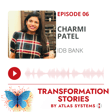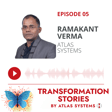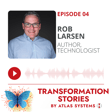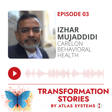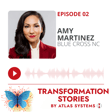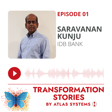Become a Creator today!Start creating today - Share your story with the world!
Start for free
00:00:00
00:00:01

#8: Sreeji Gopinathan
AI, cloud, and other breakthrough technologies and platforms are driving unprecedented change for enterprises of every size. Sreeji Gopinathan has been on the cutting edge of this transformation for over two decades, with key roles at Lupin Pharmaceuticals, Philips, Procter & Gamble, and more. In this latest Atlas conversation, Gopinathan takes a candid look at the opportunities and challenges presented by AI – a force for efficiency and growth, as well as a source of cyber-risk – and explores his own transformation as a tech leader.
Recommended
Transcript
Introduction to Transformation Stories
00:00:00
Speaker
This is Transformation Stories, a podcast from Atlas Systems, exploring how companies are leaping into the future through deliberate change and innovation. In today's digital landscape, businesses face a choice to transform or risk falling behind.
00:00:18
Speaker
Here are the insights of visionaries and change makers were driving transformation across various industries and roles. They'll share their experiences, strategies, and the most potent opportunities for success. Join us as we uncover the secrets of transformation.
Meet Sriji Gopinathan
00:00:39
Speaker
A noted thought leader and innovator in tech and digital solutions, Sriji Gopinathan is the founder of SKG Advisory, a consulting firm that works across industries. For five years he served as global CIO of Lupin Pharmaceuticals.
00:00:55
Speaker
leading the end-to-end IT t and digital portfolio of the company. Earlier, he guided IT t strategy for Wreckit in the Africa, Middle East, and South Asia region, and he has held key tech roles at Philips, Procter & Gamble, and other leading companies. In addition, for the past six years, he has acted as an advisor for Orega, an ecosystem for empowering the differently abled community.
The State of Digital Transformation
00:01:23
Speaker
All right. Well, Sreeji, thank you so much for joining us on Transformation Stories. We really appreciate your time today. Thank you, Dave. Thanks for having me. ah So, you know, our topic is generally digital transformation, and I know you have a lot of experience there. I know you have very strong viewpoint. So I just wanted to get kind of your, you know, baseline assessment of where we are with digital transformation, you know, across the business enterprise landscape.
00:01:58
Speaker
Right. um Yeah. So, I mean, digital transformation in that name got that name, you know, probably a few years ago. But there have been some sort of digitization and digitalization and some amount of transformation work that has been going on for for a longer time,
Sector Maturity in Digital Transformation
00:02:15
Speaker
right. But I guess the biggest difference now is that there is a lot more transformative technologies which is out there in the form of data analytics, AI, ML, GenAI and so on.
00:02:27
Speaker
And hence the possibility of using the power of data and digital is a lot more um rather than just the digitization and digitalization. But now if you look at the maturity of different sectors where they are, that is also different. I mean the financial industry, the BFSI sector probably is is you know, ahead of the game, they started the transformation journey a few years before, and they they probably accelerated much faster than they did it in such a way that whatever they were doing was core to run their business. Whereas in other sectors, there was a lot of catching up going on, but it's in a decent enough shape. Most of the organization is a large and, you know, to a certain extent extent some of the medium organizations as well.
00:03:19
Speaker
have done quite a bit of work in terms of creating the, you know, the so-called L0, L1, L2 systems, which means it is the shop floor systems, you know, ERP systems, lab system, manufacturing systems and so on. That is kind of, you know, there is a journey going on in some organizations still, but more or less it is there.
Challenges in Leveraging Data
00:03:43
Speaker
And now the play is in the above, the the levels above that, which is about understanding what is the data that is being generated out of the systems, how do we get some power of data out of that to drive the business outcomes um and and probably improves the productivity and and the efficiency of how the business and the people work.
00:04:07
Speaker
Now, the success ratio there ah has not been so great. um So that's that's where you know we are at this point of time. So there is a little bit of a roller coaster right there because of the success rate. Success rate probably is about 20-20, if you're personally at the best case. um So that kind of demotivates the leadership and the organization and the people a little bit.
Traits of Successful Digital Transformations
00:04:28
Speaker
But that's where we are. that's That's the current baseline that I would say where we are.
00:04:34
Speaker
And what would you say are some of the traits or the characteristics of the companies that are doing it well, ah that have had success, you know, that%? Yeah. um So, you know, there are people who are leaders in driving various types of transformations in their organization, whether it is a digital transformation, organization transformation, whatever transformation we're talking about. And then there are followers, i know the organization which follow. So when the leaders ah go through and work on certain areas, create successful use cases,
00:05:21
Speaker
um the the followers typically want to follow and do what the leaders did. without you know thinking through whether that is the right thing for them as well. right um Even if when we are looking at businesses operating in the same sectors, ah some some something that has worked in one organization need not necessarily create the same level of impact or outcome in another organization. Because it's like in know age-old bottleneck removal of a manufacturing setup. You go from one manufacturing plant to another plant.
00:05:59
Speaker
The way you can improve the efficiency of that plant is going to be different on what their process is, what the bottlenecks are, what is working, what is not working. So, the same thing right. So, in any organization when you want to focus on areas of using technology to drive business outcomes and transform how they function, if they are just going to reapply what others have done, that that probably is not addressing your problem area. If you are lucky it might, but in many cases it may not.
00:06:27
Speaker
And that's where the problem is, so instead of just reapplying the use cases, look at what is your a current level of maturity, the processes and where could potentially be your issues and bottlenecks and then try to say, okay, this is what I want to solve. Now for that, what technology is needed? Just because there is a hyper on one particular technology at a point of time, um you know, you want to look cool, sound cool and hence you want to do something.
00:06:58
Speaker
that doesn't really yield the right outcomes for the businesses. So that's what I would say ah differentiates between people, the organizations which succeed and which do not really succeed. I mean, it seems like, you know, the level of success ah is really tied to some very fundamental ah management and leadership things that are, you know, it's not really about digital, it's about, you know, strategic focus. Do you see that?
00:07:28
Speaker
yeah So, yeah, so I mean, I mentioned, you know, the the initial momentum creation. Now beyond that, even if you let us say, let us say one particular department in an organization, let us say as integrated business planning from demand planning to supply planning to production planning is looking at how to improve their processes. And if certain set of people understand what the problem is and you know, they want to address it.
00:07:53
Speaker
And if they try to address that by themselves, it might go a certain distance and it might create some success successes. But if it does not have the right sponsorship and buy-in from the leadership um you know ah then and Then it might see initial success and then sustenance of that and and and spreading that success across the different parts of your organization ah may not happen. So even when you look at a large organization, you might have a central planning function and then probably decentralized supply planning and production planning. And you have addressed that for one path you know ah in that.
00:08:33
Speaker
and now you know one one department of supply planning and planning, one plant, one manufacturing plant. And then if you're not able to scale that into other areas of the business, then it is just an isolated success that you will have. Now, when are you going to be able to replicate that across the organization? That's when the leadership believes you know that, yes, I have seen that this is producing good results. Let me you know help the organization scale that across the different parts.
00:09:00
Speaker
That's where the change management becomes very important.
Opportunities in Key Sectors
00:09:03
Speaker
And change management, the top down approach has to be going hand in hand with a bottom up effort. So the top down sponsorship, setting the clear direction, vision and expectation setting. And if there are ah people who doesn't believe in that storyline, then listening to them, understanding what why why that is so and and helping them and understand the cause of that particular program and the transformation journey that the organization in is in and then the bottom-up effort of the actual SMEs and the people who are actually doing the work will start showing the results and replication becomes faster as well in these kind of cases.
00:09:49
Speaker
So for the companies that are succeeding with this, what do you think are the next big opportunities ah in transformation? what are the What are the things that they should be targeting or aiming for now? i mean First and foremost, if you take the lead from what I just said, um you know ah don't look for quick successes or quick wins. There might be low-hanging fruits. Don't get me wrong.
00:10:16
Speaker
right There might definitely be long hanging fruits. There might be, it is not, there might be, there will be long low hanging fruits in most organizations. and And once you identify them, of course you can move fast and get the benefits out.
00:10:29
Speaker
But then you know ah just reapplying somebody else's use case in your organization and saying, I have done it, um don't do that. you know start Start with you know reimagining, thinking through um you know what is the problem. um That is the opportunity for me.
00:10:48
Speaker
right, thinking through what is the problem ok, then you think about how to address the problem. Now that thinking through what is the problem should not also be left to only the technology teams in the organization. It has to be a joint exercise between um the business, the functions and the technology teams ah to understand you know what is it that we have to solve, where is it that we have to go compared to where we are.
00:11:14
Speaker
What kind of improvements can we potentially make if we do that? It could be a sales ah productivity enhancement of a pharma organization or an FMCG organization or whichever organization that we're talking about. It could be um you know the way marketing is done, and the content that is generated. How do you make it a lot more effective and faster and and getting that message out there so that the go-to market becomes a lot more efficient?
Patient-Centric Solutions
00:11:44
Speaker
ah It could be in a manufacturing type of setup looking at some of the typical use cases that if somebody has not done it is is like yield improvement of a manufacturing line. You know there the combination of digitized layer with the data that comes out and then applying the algorithms on top of that to understand what are the most influential variables that you can isolate and then using ah the machine learning process to target those variables ah to narrow down to the range which can create the maximum output or the yield is is something that is you know a lot of organization has tried and if somebody has not done it they should go after it.
00:12:28
Speaker
Predictive maintenance is another one you know which there is lot of success stories and this will be applicable for most of the organization. But how do you do that predictive or maintenance for your organization will be more likely specific to your organization because it depends on the line that you have, the speed of the line, the temperature,
00:12:48
Speaker
conditions, ambient conditions, vibration conditions. Now all those things play a role in identifying how do you create your use case and algorithms to ah decide on what condition should I take call that there is a predictive maintenance required instead of letting the line fail and the batch go to waste.
00:13:09
Speaker
you know Now, if I look at BFSI or e-commerce type of businesses, it is all about pretty much you know connecting to the consumers, customers and understanding what their preferences are and personalizing you know the the the approach towards those customers so that you can target them with what they need. And you know unfortunately, that has become, that has been overdone in many cases.
00:13:37
Speaker
without clearly understanding what is the preference of that customer and hence it becomes an irritating factor for the for the customer. So, you should not overdo it, you should understand what is the frequency probably this customer will like so that he is more likely to take a look at it, click on it, open it and take some action instead of over overloading information.
Role of AI and ML in Transformation
00:13:57
Speaker
So, yeah I can go on and on depending on the different departments and the functions.
00:14:02
Speaker
So, there are a lot of these kind of opportunities which you need to look at in specific areas where you can improve. Now, if I come back with me one more case, Pharma and healthcare, ah the patient centricity of what you do, right, rather than ah what you believe is needed, right. So, the thinking has to be around the patient to understand how do you address a cardio patient or or a neuropatient or you know whichever condition or therapy that we are talking about. So, that you design your solution around that and and hence it is not just that initial buying of that proposition which will improve the condition of that patient, but also the stickiness improves and hence the patient has a higher chance of protecting himself or herself over the longer period of time. um So, that usability, UI, UX,
00:15:00
Speaker
you know getting support much faster, hand holding when that is needed because in many cases it could be elderly patients and the ecosystem that is needed around that you know in providing care and bringing the family into the ecosystem all that needs to be thought through when you design a solution.
00:15:20
Speaker
So we've been talking for 14 minutes and and you haven't mentioned AI yet. So just curious, like what do you think ah is AI's role in in driving how people are thinking about transformation and and and where is that going? Yeah, I briefly mentioned AI, ML and Gen AI, but I try not to throw that terminology too much when I talk these days because you hear about it too much. Now, um You know, um AI, GenAI, ML has become almost kind of the norm now. It is not something which you consider as something which is an optional thing for you to consider and you know, adopt in your organization. and So, you know, the the latest hype is GenAI, right? But what is GenAI? If you really think about it, it is actually a much more sharper focused
00:16:18
Speaker
ah you know enriched search functionality, if you really think about it, I might be over simplifying, but that is what it is right. there are there is There is data all over the place, you are you are now creating sharp prompts which is basically search criteria, and which goes and looks at the ah data and then there are mechanisms in that.
00:16:44
Speaker
where you are able to understand the data which is being picked up from the databases, enrich it and you know bring it back to you in a more contextual manner and not just links of what you have searched for.
00:17:00
Speaker
okay So, if you now think about it, this is this is something which can generate value for organization multiple parts of the ah parts of the different departments, right. One is obviously I briefly mentioned about marketing, I did not use gen AI, but you know Janai can be used ah to accelerate the marketing efforts, the content creation agency and internal efforts can be become more efficient. um The baseline can be created much, much faster. And then of course, depending on regulatory aspects that needs to be considered, considered depending on specific messages that the organization want to ensure that it is in that marketing campaign that you're doing. or messaging that you're doing. So, that is the layer where all the effort can go in rather than creating messages content from scratch. um So, AI, ML and GenAI is part of it. So, I talked about yield optimization. You know, ML is core to that. You know, either algorithms that I mentioned are ML algorithms.
00:18:05
Speaker
Now, you have 3 years of data, 5 years of data, you do electronic data assessment of and what the data is actually telling you. Then you try and apply certain algorithms, it could be random forest or whatever algorithm you want to apply on it and then you get certain outcomes which you then go and verify whether it is actually giving you the desired outcomes and that's when you decide okay this is the algorithm which is the most fit, this is this is the machine learning algorithm which is actually giving me the best out outcome.
00:18:38
Speaker
And then you start narrowing down the parameters you want to target and you get the best outcome in the possible before you put it into production. So yeah, I mean, whatever we have discussed so far actually is based on AI, ML and Gen AI.
Cybersecurity & Data Privacy
00:18:55
Speaker
I talked about Salesforce productivity and enhancement. In the old world, it is about giving giving a CRM system, right, which gives you a list of customers you have to go to, the route that I have to follow today you know, the time that I need to plan for travel in between and all those kind of things. But today's Salesforce productivity is not about the salesperson sitting there and looking at okay, what did I discuss with this particular customer store doctor last time, you know, did I did i actually get my company to deliver ah the sample or the ah the specific things that the doctor has asked for or the customer has asked for.
00:19:36
Speaker
You know that that is how it used to be run by looking at the CRM. Today the ah AI and the ML algorithms uses the CRM data. which is also a lot more intelligent these days because it captures a lot of soft data based on the conversations that is going on. The yeah ERP data, external market data which gets applied by different companies like ne Nielsen, IQVI and so on. That data is turned overnight using the algorithms that is developed and it is then coming back as specific bullet points or we call them nudges to tell that sales rep.
00:20:13
Speaker
or the medical rep and that these are the top 3 things that you need to actually converse in the 2 minutes you get in the store or in with the customer or with the doctor. So that algorithm is running in the background which takes away lot of time commitment that is needed from the rep to churn the data himself or herself.
00:20:35
Speaker
you You can travel, you can go there, you open it up, you see that in your tab or, you know, phone or whatever. Okay, these are the points I need to talk as as the delivery happened to his store, which has been committed. All that is available, and they are going in. So, AIML is core to all of those examples that I was quoting. And what about security and privacy? I mean, how do you think that's shaping conversation, shaping the planning ah right now?
00:21:04
Speaker
Yeah, it's so yeah it's it's a matter of, um how how do you say, serious consideration, especially with what has happened over the last couple of weeks as well. um There has been almost like a standstill across the globe, right, at least for minimum, at least 24 hours, maybe more in some of the organizations and probably there are ripple effects still going on. um So, I mean,
00:21:33
Speaker
It cannot be emphasized on how important it is. ah not just for the organizations that is you know doing all these kind of data digital connected you know transformation work, but also for the providers who become part of the supply chain. um So, if you look at the traditional world when we use the word supply chain, supply chain is about supplying the raw materials and packing materials and the trucks and the transportation mechanisms for an organization. Today, supply chain means
00:22:08
Speaker
our organization which are providing software applications, cyber security, protection, all those providers as part of your supply chain. yeah it That is the way of living your business now. If that fails, your business stops. um So, you know, while a CIO or a CISO of an organization is, is you know,
00:22:33
Speaker
taking all efforts to make sure that their data is protected, the the data privacy is taken care of, you know, the supply chain partners, whether it is the, ah you know, production application provider organization, or it is a systems integrator, or it is a support organization, or of somebody who is running your security operations center, they need to start believing that what I am doing is part of the supply chain of that end user organization. If I screw up, I screw them as well. right It is not just an application that's stopping. you know You're stopping the business. So um you know you know the the particular case is is if you if simplistically, if you look at it, it's about not doing a proper job as far as the batch was concerned, the changes were concerned.
00:23:28
Speaker
I don't know what actually happened. Fucking about CrowdStrike here. Yeah. I might be making assumptions here, but you know it looks to me like something went amiss in terms of quality testing and and making sure ah you know it has been looked at properly before the deployment happened.
00:23:50
Speaker
because and it it impacted everybody. It did not impact a specific you know you know company or specific department or a specific version of the operating system. Everything in Windows, Microsoft operating system got impacted. So something is not right there. um So you know I know it that's that's a company. I have a lot of respect for that company, a fantastic company, fantastic product that they have.
00:24:16
Speaker
and I've used them, I have good relationship with them. But then at some point, maybe some, you know, some complacency creeped in. I don't know. and I might be making a assumption here, but something went. So, but the seriousness of that, if I make a mistake, it impacts a lot more people. So, cybersecurity, data privacy, data protection, um it's equivalent to running your business safely. It's not an optional thing anymore.
Atlas Systems' Support in Transformation
00:24:46
Speaker
Right. Just thinking about, you know, Atlas and how companies ah can turn to Atlas or, you know, companies like Atlas to ah make better decisions about transformation. um Do you have any thoughts about the role of ah of an Atlas in making things happen and and making sure that they go smoothly? Yeah, I mean, I've been now
00:25:15
Speaker
Engaged with Atlas systems for for a while, I've met the the the founder, CEO, I've met the teams, I have been talking to you. um You know, Atlas to me is ah is a mature organization um who has clarity of thought, um not trying to boil the ocean, and being very clear on oh where they want to play.
00:25:44
Speaker
and you know how they want to play. That's one unique a characteristic that I find in in Atlas, which sometimes is refreshing because most of the organization claim they will do everything. They want to do everything. They want to get into everything, and then don not doing a good job at the end of the day. So the focusing on the quality of work that needs to be delivered, understanding the customer, understanding what the customer requirements and needs are,
00:26:13
Speaker
And then focusing on ah turning around very, very quickly, yeah showing that agility to address those problems and being with that customer ah through that journey. um you know that's That's where I think Atlas has shown shown the resilience and and capability and to work with the customer. So they are operating across, yeah you know you have certain products in terms of third party compliance assessment, risk assessment, you have AI ops,
00:26:41
Speaker
And you know you have pretty strong teams when it comes to IT infrastructure services. You have pretty strong teams when it comes to AI and GenAI related work that is going on. And you're also having pretty strong customer service people in your organization. um And you know all of that put together if you really think about it. you know Risk assessment, AI ops, infrastructure strength,
00:27:10
Speaker
AI and GenAI strength, um you know you can actually get into different areas of an organization to understand where the improvement opportunities are or where the disruptive opportunities are. And
Embracing Change: Closing Remarks
00:27:23
Speaker
you can bring all of that together, not just for the IT teams, not just in managing their operations, but in actually looking at value creation for ah the ah the the business and the organization. That's how I see Atlas, and I'm really happy to be engaged with you.
00:27:42
Speaker
but Thanks so much, Sriji. We really appreciate your time today and your insights. It's been great speaking with you. Thank you, Deva. Thanks again for having me. And that's a wrap on today's episode of Transformation Stories. If you found this episode as enlightening as we did, be sure to subscribe, rate, and leave a review. Your feedback fuels our mission to bring you more thought-provoking conversations.
00:28:08
Speaker
As we conclude today's journey, remember that transformation is within reach for every business, and it starts with deliberate choices. Keep pushing boundaries, seeking new opportunities, and embracing change. Until next time, this is Transformation Stories.


